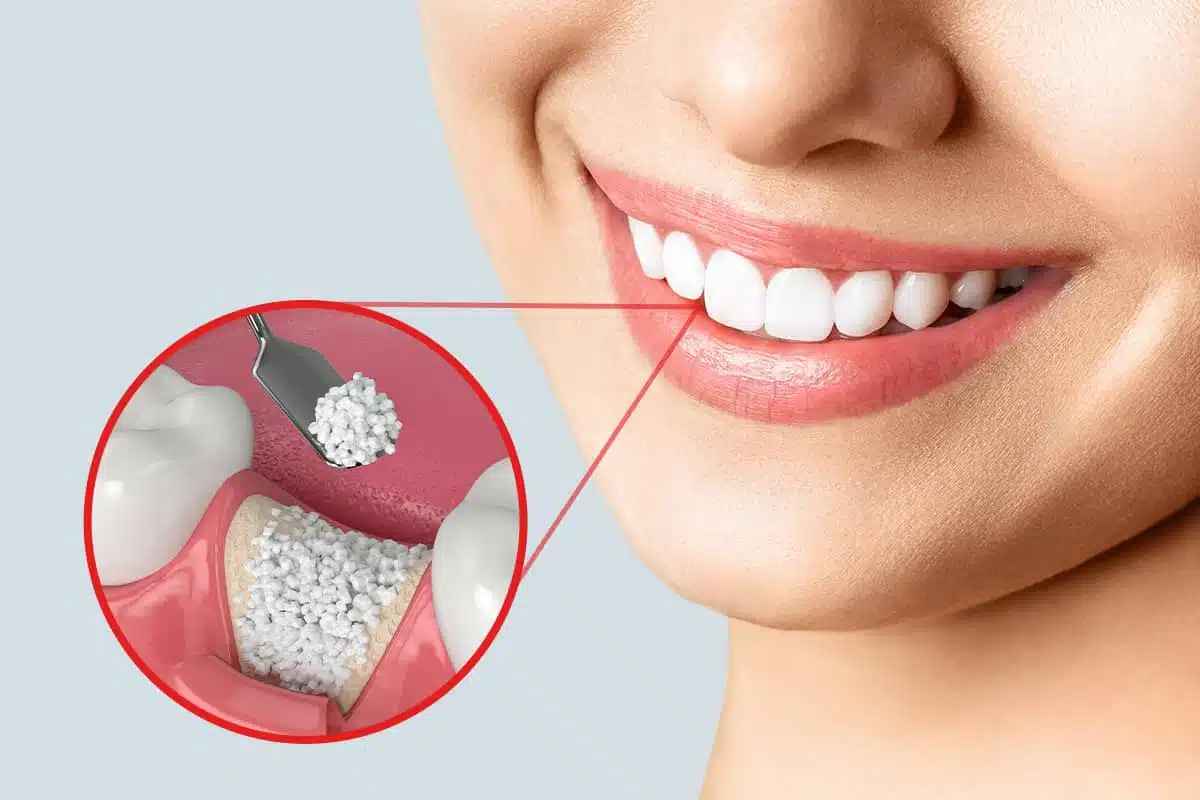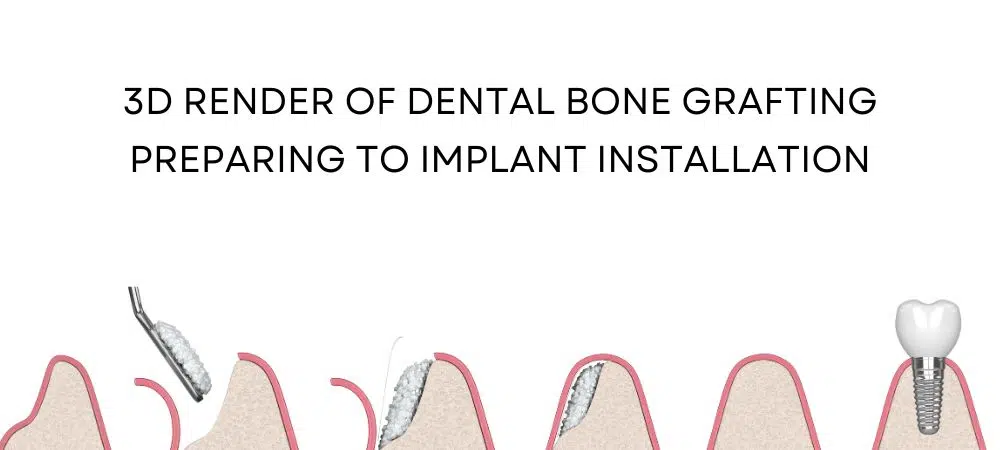
The dental bone graft procedure restores bone in the jaw, creating a solid foundation for the permanent restoration of missing teeth. This advanced technique has numerous benefits. We will discuss these benefits and other aspects of dental bone grafting and dispel some common myths surrounding the procedure.
Trust Dr. Gallardo’s 30+ years of expertise to restore your smile with advanced bone grafting techniques.
The Benefits of Bone Grafting in Dentistry
- Supports jaw health: Bone grafting helps prevent further bone loss and provides a strong base for implants.
- Preserves dental work: It reinforces the stability of bridges, crowns, or existing teeth.
- Improves facial appearance: Replenishing lost bone can restore your natural look and profile.
- Aids in recovery: After injury or periodontal disease, bone grafting helps repair damage and promote healing.
- Minimizes discomfort: Modern techniques often reduce pain and downtime, making recovery smoother.
What Is Dental Bone Grafting?
In a dental bone grafting surgical procedure, bone tissue is transplanted to the jaw bone. This is done to replace missing or damaged bone that may have occurred as a result of tooth loss, gum disease, or injury. Once the graft is securely placed, it stimulates new growth of bone and eventually integrates with the existing bone structure, providing a stable foundation for dental restorations such as implants, bridges, and crowns.

Benefits of Dental Bone Grafts
Bone Graft Dentistry Can Help You Avoid Tooth Loss
Preserving natural teeth is one of the primary benefits of dental bone grafting. When a tooth is lost or extracted, the surrounding bone begins to deteriorate. By performing a bone graft, the jawbone can be strengthened and stabilized, preventing further tooth loss and maintaining the integrity of the remaining teeth.
Bone Graft Dentistry Can Improve Your Bite and Chewing Ability
A healthy and strong jawbone is essential for proper bite function and chewing ability. Dental bone grafting can help restore the jawbone’s strength and stability, improving overall dental function and making it easier to eat and speak without discomfort.
Bone Graft Dentistry Can Help You Get Dental Implants
Dental implant sites require a sufficient amount of healthy bone tissue for successful placement and long-term stability. When considering cases involving bone loss, dental bone grafting helps to create the bone structure required to facilitate dental implants successfully.
Bone Graft Dentistry Can Improve Your Facial Appearance
Tooth loss and bone deterioration can lead to changes in appearance. The skin will sag and the face’s structure can look sunken, which can even change the appearance of facial features. By restoring the jawbone through dental bone graft surgery, these negative effects can be minimized or even reversed, resulting in a more youthful and healthy appearance.
Bone Grafting Can Prevent Jawbone Loss
A natural bone resorption process occurs when teeth are lost or extracted, leading to a decrease in bone density and strength. Dental bone grafting can help prevent this loss by stimulating new bone growth and maintaining the integrity of the jawbone.
Trust Dr. Gallardo, your expert periodontist for bone graft dentistry
With numerous successful procedures and exceptional reviews, Dr. Gallardo ensures your bone graft is handled with care and expertise.
How Does a Dental Bone Graft Work?
To begin dental bone grafting procedures, the surgeon makes an incision in the gum tissue, exposing the underlying bone. The donor bone graft materials, which can be harvested from the patient’s own body, from a donor (allograft bone), or from synthetic materials, are then placed in the area of bone loss. The graft is secured, and sutures are used to close the gum tissue. The type of graft material needed is determined at the patient consultation.
Over time, the transplanted bone grafting material will integrate with the existing bone structure, stimulating new bone formation and creating a stronger, more stable foundation for dental restorations, such as implants. This process, osseointegration, can take several months but is essential for ensuring the graft is successful and the dental restoration is secure. Dental bone grafts not only replace lost bone tissue, but they also help to prevent further bone loss while maintaining the structure and appearance of the jawline.
What Types of Dental Procedures Can Benefit From Bone Grafting?
Dental bone grafting can be beneficial in a variety of dental procedures. Here are some examples where bone grafting can play a crucial role in the success of the treatment:
Bone Grafting Can Help Create a Solid Foundation for Dental Implants
As mentioned earlier, dental implants require a sufficient amount of healthy bone for successful placement and long-term stability. For cases involving bone loss, dental bone grafting creates the required foundational bone structure to support a successful dental implant placement.
Bone Grafting Can Improve the Stability of Bridges and Crowns
Bridges and crowns rely on the support of the underlying bone structure. If the jawbone has been compromised due to tooth loss or gum disease, a bone graft can help restore the necessary support, ensuring the stability and longevity of these dental restorations.
Bone Grafting Can Help Preserve Natural Teeth in Need of Extraction
In some cases, a tooth may be at risk of extraction due to severe damage or infection. Bone grafting can be used to strengthen the surrounding bone, potentially saving the natural tooth and avoiding the need for tooth extraction.
Bone Grafting Can Aid in Facial Reconstruction After Injury or Trauma
Accidents and injuries can result in significant damage to the facial bones, including the jawbone. Bone grafting can be used as part of a comprehensive facial reconstruction plan to restore the jawbone’s structure and function, improving the patient’s overall appearance and quality of life.
Bone Grafting Can Help Reconstruct Jawbones That Have Been Damaged by Periodontal Disease
Periodontal disease (gum disease) can cause significant damage to the jawbone over time. In advanced cases, bone grafting may be necessary to restore the jawbone’s structure and function, allowing for the successful treatment of periodontal disease and the placement of dental restorations.
Bone Grafting Myths
There are several misconceptions about dental bone grafting that can cause confusion and apprehension among patients. Here, we address some of these myths:
Myth #1: Grafting Requires Lengthy Downtime and Is Very Painful
While it’s true that patients should rest on the first day after the procedure, normal activities can typically be resumed after a day, and physical activity can be resumed after a week. Most patients don’t even require over-the-counter pain medication.
Myth #2: A Bone Graft Is Always Necessary for Dental Implant Patients
Appropriate treatment planning is essential to determine if bone grafting is necessary for a successful dental implant surgery. In some cases, bone grafting and dental implant placement can be completed in one appointment, while other patients may not require bone grafting at all. An assessment by a qualified dental professional is needed to determine the best course of action.
Myth #3: It’s Not Worth Going Through Grafting Just to Get Dental Implants
Dental implants provide functional, beautiful teeth that preserve the bone and don’t need to be removed like dentures. Dental implants can enhance a person’s overall quality of life and are an excellent choice for individuals with missing teeth. In cases where bone grafting is necessary, the benefits of dental implants often outweigh the temporary discomfort and healing time associated with the grafting procedure.
Frequently Asked Questions about Dental Bone Grafting
The healing time for a dental bone graft varies depending on the individual and the specific procedure. You will feel better between 1 and 2 weeks after surgery. Typically, full integration of the bone graft with the existing bone takes between 3 to 6 months. Your dental professional will monitor your progress and determine when it’s safe to proceed with any additional dental procedures, such as implant placement.
Some potential downsides of dental bone grafting include post-operative discomfort, swelling, and a temporary change in diet. However, these downsides are generally short-lived and can be managed with proper post-operative care. The benefits of bone grafting, such as improved dental function and appearance, often outweigh these temporary inconveniences.
Dental bone grafts have a high success rate, with studies showing success rates of over 90%. The success of a bone graft can be influenced by factors such as the patient’s overall health, oral hygiene, and the dental professional’s skill. Selecting an experienced dental professional, like Dr. Gallardo, helps to ensure the best possible outcome for your bone graft procedure.
Dental bone grafts, procedures designed to restore bone in the jaw, are considered relatively routine procedures by dental professionals. While any dental surgery carries some risks, dental bone grafting is considered safe and effective when performed by an experienced dental professional. Following your dentist’s post-operative instructions and maintaining excellent oral hygiene can help minimize the risk of complications and promote faster healing.
The duration of the bone graft procedure itself typically ranges from 45 minutes to over an hour, depending on the complexity and the type of graft being performed. However, the total time in the dental office may be longer due to preparation and post-procedure care instructions.
In some cases, alternatives to bone grafts may be available, depending on the specific needs of the patient and the condition of the jawbone. These alternatives might include using growth factors to stimulate bone regeneration or opting for mini dental implants that require less bone structure. Discussing these options with your dental specialist can provide clearer guidance tailored to your situation.
Learn More From An Expert
Before deciding on a bone graft, it’s essential to have an evaluation done to determine if a bone grafting procedure is necessary. If you are seeking an affordable dental implant service in Miami, Dr. Gallardo is the best option. To learn more about bone grafting and dental implants at our Miami-based offices, feel free to call 305-447-1447 today and schedule an appointment with one of our experienced periodontists.